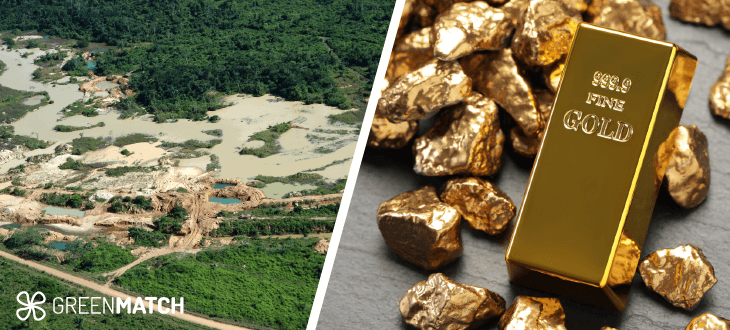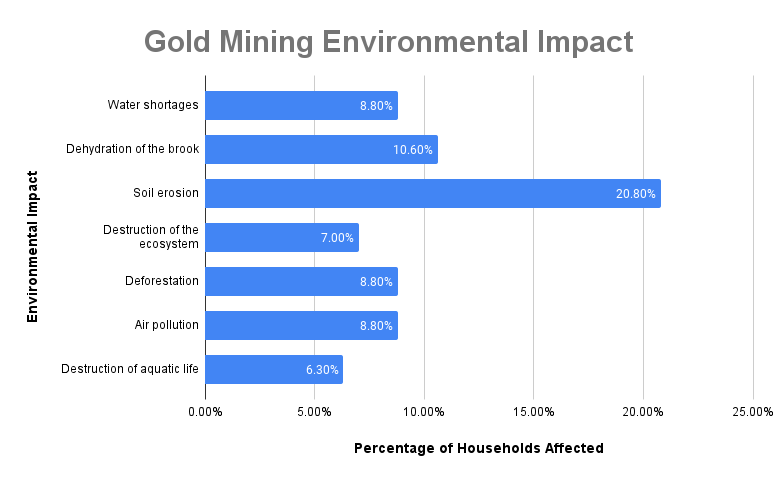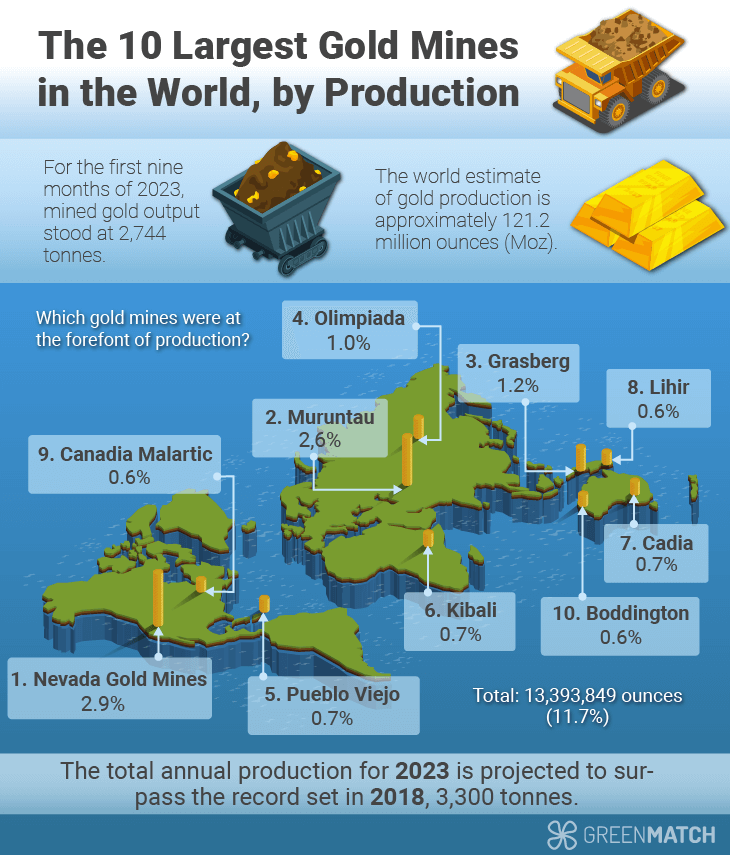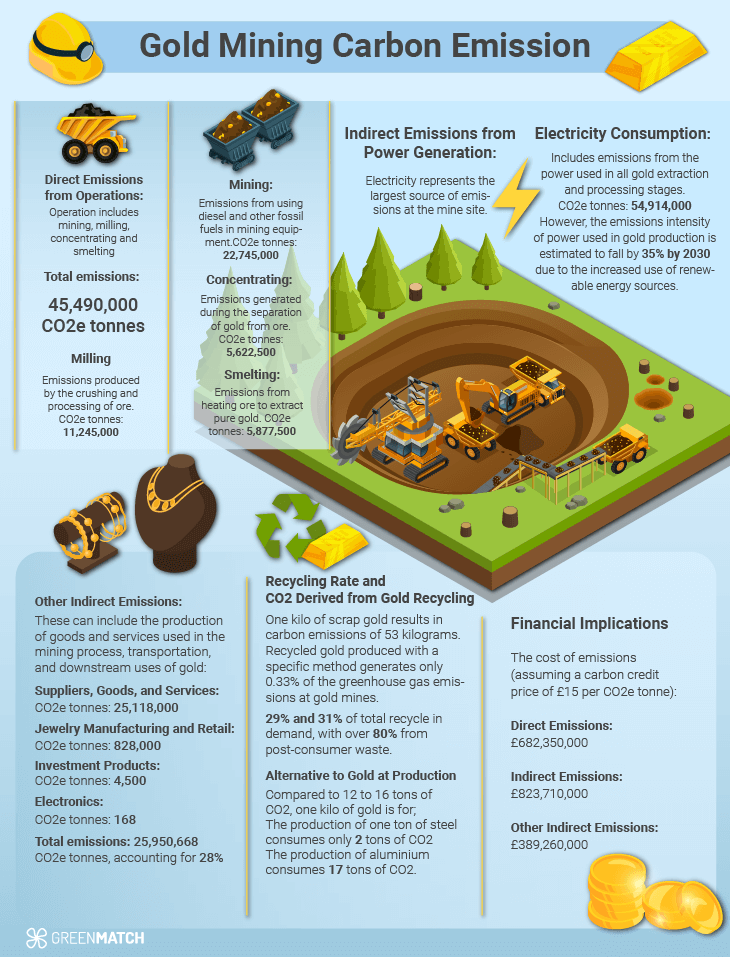- GreenMatch
- Blog
- Is Gold Mining Bad For The Environment? Statistics, Facts And Quotes
Environmental Cost of Gold Mining: A Global Perspective

Gold mining has significant negative impacts on the environment. It can contaminate drinking water, destroy pristine environments, and endanger the health of people and ecosystems. The process involves using toxic substances such as mercury and cyanide, which can pollute water and land. For instance, producing gold for one wedding ring alone generates 20 tons of waste.

Yes, gold mining is indeed harmful to the environment. It is considered one of the most destructive industries in the world due to its significant environmental impacts.
Gold mining is a global business with operations on every continent except Antarctica. China was the largest producer in the world, accounting for around 10% of total global production. In 2021, China's gold mine production accounted for more than 12% of the worldwide mine production.
The global gold industry's carbon footprint comprises 0.3% of global emissions, more than all intra-European emissions.
Global gold production has grown exponentially since the 1800s, with 86% of all above-ground gold mined in the last 200 years. The best estimates suggest that around 208,874 tonnes of gold has been mined throughout history, of which around two-thirds have been mined since 1950. In 2023, mining produced 3,644.4 tonnes of gold, second only to the record year of 2018.
The environmental impacts of artisanal gold mining are also significant. The digging of extraction wells can lead to the weakening of lands by creating underground voids and cavities, while waste rock discharges and cyanide wastes from gold mining are often abandoned on the land
This has significantly led to o deforestation and degradation of landscapes. It can cause soil erosion, water shortages, and destruction of ecosystems. The use of chemicals such as mercury and cyanide in artisanal and small-scale gold mining is a significant environmental issue.
While gold mining contributes to the global economy, it has significant environmental impacts. These include contamination of water and land, destruction of ecosystems, and contribution to global emissions.
What Do We Mean With Gold Mining Exactly?
Gold mining refers to the process of extracting gold from the earth. This extraction can occur in various ways, depending on the location and nature of the gold deposits.
The extracted gold ore is then processed and transformed into a metallic alloy of substantial purity, known as doré, which typically contains between 60-90% gold.
Gold mining is a significant industry worldwide, with large corporations conducting most of the mining. However, the high value of gold has also led to the proliferation of small, artisanal miners, particularly in many parts of the Global South.
It's important to note that gold mining, like all mining activities, can have significant environmental and human rights implications. These can include habitat destruction, water pollution, and health and safety risks for workers, particularly in mines with less regulation.
| Year | Global Gold Production (in tonnes) | Top Gold Producing Country | Top Gold Mining Company |
|---|---|---|---|
| 2020 | 3,200 | China | Newmont Corporation |
| 2021 | 3,100 | Australia | Barrick Gold Corporation |
| 2022 | 3,000 | Russia | Newcrest Mining Ltd |
| 2023 | 2,900 | United States | AngloGold Ashanti |
Environmental Impact of Gold Mining
Gold mining, while a lucrative industry, has significant environmental impacts that are often overlooked. Gold mining can have substantial environmental impacts. It can displace communities, contaminate drinking water, hurt workers, and destroy pristine environments.
For example, the Environmental Protection Agency (EPA) in the United States estimates that abandoned hardrock mines have contributed to the contamination of 40% of the country's rivers and 50% of all lakes. This has shown that mining has contributed to severe public health, safety, and environmental concerns.
Let's delve into the environmental repercussions of gold mining and the scale of its impact.
Total Impact per Year
The global gold mining industry has a staggering impact, producing an estimated 3,531 metric tons of gold annually. This equates to a market value of approximately £89.31 billion.
It generates approximately 180 million tonnes of toxic waste annually, often containing dangerous chemicals like arsenic, lead, mercury, and cyanide.
Impact per Day
Daily, the gold mining industry extracts an average of 9.7 metric tons of gold, leading to extensive environmental disturbances.
The daily operations of gold mines can also result in the dredging of rivers and the displacement of large amounts of soil and rock, leading to water contamination and habitat destruction. For instance, the use of cyanide and mercury in gold mining can release these toxic substances into waterways daily, affecting aquatic life and human health.
Impact per Usage
Gold is utilised in various industries, including electronics, jewellery, and aerospace. Its demand and subsequent environmental impact are substantial, with approximately 50% of the world's gold supply being used in jewellery production alone.
Despite recycling efforts, the demand for gold far exceeds the amount recycled, which does little to offset the environmental damage caused by mining.
Top Largest Gold Mining Economies
China is the world's leading gold mining country, followed by Australia and Russia. Around 31% of the world's production comes from these countries.
According to the World Gold Council, China accounts for 11% of global gold production, while Australia and Russia account for 10%.
The largest gold mining countries as of 2023, along with the number of tons generated, are as follows:
| Rank | Country | Gold Production (tons) |
|---|---|---|
| 1 | China | 420 |
| 2 | Australia | 330 |
| 3 | Russia | 310 |
| 4 | United States | 200 |
| 5 | Canada | 180 |
| 6 | Indonesia | 160 |
| 7 | Peru | 130 |
| 8 | Ghana | 130 |
| 9 | Mexico | 110 |
| 10 | South Africa | 101 |
The mining industry in these countries has driven economic growth and attracted substantial foreign investment. However, the price of gold is a crucial factor influencing mining activities. As of 2024, gold per ounce was valued at £1,351. The fluctuation in gold prices affects the profitability of mining operations and can lead to the exploitation of lower-grade ores when prices are high.
What is so bad about Gold Mining for the Environment
Gold mining has been identified as a significant source of environmental degradation.
Gold mining can have devastating effects on nearby water resources, contaminating them with toxic mine waste that contains dangerous chemicals such as arsenic, lead, mercury, and cyanide. This pollution can endanger the health of people and ecosystems.
Gold mining is detrimental to the environment due to:
- Water Pollution: Mining discharges can contaminate water sources with arsenic, lead, mercury, and cyanide.
- Deforestation: Large tracts of land are cleared for mining operations.
- Soil Erosion: The removal of vegetation and soil structure leads to erosion.
- Greenhouse Gas Emissions: Gold mines emitted, on average, 0.85 tonnes of CO2, equivalent to every ounce of gold produced.
- Mercury Pollution: Gold mining is a significant source of mercury pollution, which has severe health impacts.

What is the Impact of Gold Mining?
Beyond the immediate environmental consequences, gold mining has broader social, economic, and geopolitical implications.
It can create jobs, generate tax revenue, and attract foreign direct investment. The industry employs millions worldwide and was valued at around £100 billion in 2023. For instance, in 2020, World Gold Council (WGC) member companies directly paid £6.5 billion in employee wages and £5.7 billion in tax payments to governments.
Local employees make up 95% of the WGC members’ in-country workforce, halving the average percentage of expats (from 10% to 5%) over the past seven years.
Recent Incidents and Safety Concerns
A recent tragedy highlights the ongoing dangers of unregulated mining activities:
- On July 6, 2024, a landslide struck an illegal gold mining operation in Tulabolo, Bone Bolango district, Gorontalo province, Sulawesi, Indonesia.
- At least 58 people were killed, with 23 bodies recovered as of July 11, 2024.
- The landslide was triggered by torrential rains that had been pounding the area since the previous day.
- The remote location, thick mud, and continuing rainfall hampered rescue efforts.
This incident underscores the risks associated with unauthorised mining operations across Indonesia's mineral-rich archipelago.
Top 5 Largest Gold Mines
The top five largest gold mines in the world, based on their production, are:
- Nevada Gold Mines, US.: This is the world's largest gold mining complex, with six mines producing over 3.3 million ounces.
- Muruntau, Uzbekistan: This state-owned mine is one of the world's deepest open-pit operations, producing just under 3 million ounces of gold, representing over 80% of Uzbekistan's overall gold production.
- Grasberg, Indonesia: This mine is one of the world's largest gold and copper reserves. It is an open-pit mine operated by PT Freeport Indonesia, a joint venture between the government of Indonesia, Papua, and the American company Freeport-McMoRan.
- Olimpiada, Russia: This mine produced 1,998,000 ounces of gold in 2022, making it one of the largest gold mines by production.
- Boddington, Australia: This mine produced 813,000 ounces of gold in 2022. It is one of the largest gold mines in Australia

Future Trends and Predictions
The gold price predictions for 2024 show a significant range, reflecting the uncertainty in the market:
- World Bank: £1,662 per ounce
- IMF: £1,512 per ounce
- Goldman Sachs: £1,818 per ounce
- UOB: £1,875 per ounce
- Consensus Forecast: Approximately £1,789+ per ounce
Key Factors Influencing Predictions
- Federal Reserve Policy: Many forecasts are based on expectations of the Fed cutting interest rates. Earlier rate cuts could lead to higher gold prices.
- Real Interest Rates: There's a strong negative relationship between gold prices and real interest rates. Declining real rates are expected to push prices higher.
- Economic Uncertainty: Ongoing global economic uncertainties and geopolitical tensions will likely support gold as a haven.
- Inflation Expectations: The inflation outlook will be crucial in determining gold's attractiveness as an inflation hedge.
- US Dollar Strength: The anticipated retreat in the USD across 2024 is seen as a key positive driver for gold.
While there's a wide range of predictions, the consensus seems to lean towards a moderately bullish outlook for gold in 2024. Most mainstream financial institutions expect gold to trade between £1,600 and £1,900 per ounce by the end of 2024, with the potential for higher prices if economic conditions are favourable for gold.
Is Gold Toxic?
In its pure form, gold is not toxic to the human body. It is biologically inert, passing through the digestive system without being absorbed.
However, the process of gold mining can have detrimental effects on the environment and human health. Such as
- Lack of proper safety equipment.
- Vulnerability to natural disasters such as landslides and flooding.
- Exposure to toxic substances like mercury and cyanide used in gold processing
Can Gold Be Recycled?
Yes, gold can be recycled. Gold is one of the most consistently recycled materials on the planet. Since its discovery, only 2% of all the gold mined needs to be accounted for, either having been dumped or lost track of.
Recycling gold has a considerably lower environmental impact compared to mining. For instance, high-value gold scrap recycling in Germany results in a cumulative energy demand (CED) of 820 MJ per kg of gold, significantly lower than the CED for newly mined gold.
Moreover, the economic impact of gold recycling direct Gross Value Added (GVA) is significant. For instance, the GVA per tonne of recycled gold is approximately approximately £12 million.
The following table presents the most current data available on the environmental impact of gold recycling compared to virgin gold mining:
| Impact Category | Recycled Gold | Virgin Gold | Reduction (%) |
|---|---|---|---|
| Cumulative Energy Demand (MJ/kg) | 820 | ~8,000 | ~90 |
| Global Warming Potential (t-CO2-Eq./kg) | Lower | 1 | Significant |
| Waste Generated (tons per wedding ring) | Less | 20 | >95 |
| Environmental Impact (overall) | 99% lower | High | 99 |
However, the recovery rate for gold from electronic scrap is currently only about 15 per cent. Some companies, like The Royal Mint, are investing in technology to recover gold from e-waste and are using recycled gold in their products.
According to the World Gold Council, the year recycled gold supply in 2022 increased by 1% but remains 30% below the all-time high in 2012.
| Year | Recycled Gold Supply (tonnes) |
|---|---|
| 2012 | 1,632 |
| 2022 | 1,144 |
However, in the first quarter of 2024, the global gold recycling sector experienced a significant increase, with volumes rising by 12% year-over-year. Q1 2024 saw record mine production, increasing 4% year-over-year to 893 tonnes.
This surge was largely driven by consumers in China selling jewellery in response to economic challenges from the previous year. The total recycled gold during this period reached 350.8 tonnes.
Regional Variations in Recycling
Recycling trends varied across regions:
- Asia: China led the growth, while countries like India saw slower increases.
- Europe and US: Consumers were motivated to sell gold jewellery due to significant price hikes.
- Thailand: Recycling supply remained relatively muted despite price rallies attributed to substantial gold liquidation during the COVID-19 pandemic.
- Middle East: Showed a marginal increase in recycling volumes but recorded a year-on-year decline.
Recycled gold is becoming increasingly significant in the overall gold supply. In the first quarter of 2024, two-thirds of the 3% growth in total gold production was attributed to recycling, highlighting its critical role in the market.
Is Gold Biodegradable?
Gold, in its pure form, is not biodegradable. It is a stable element that does not break down naturally in the environment.
While gold itself is not biodegradable, recent studies have shown that gold nanoparticles can be degraded in vitro by cells, with smaller particles degrading faster. This could be used in various clinical applications and made biodegradable under certain conditions.
The result is significant, especially in medicine, where gold nanoparticles are used for various therapeutic applications, including cancer treatment.
Is Gold Mining Sustainable?
The sustainability of gold mining is a complex issue with both positive and negative aspects. This is because gold mining has been a cornerstone of economic development for many countries, providing jobs and infrastructure and significant contributions to national GDPs.
The gold mining industry also has a pathway to decarbonise and reach net zero by 2050, in alignment with the Paris Agreement. The Responsible Gold Mining Principles (RGMPs), launched in 2019, set clear expectations for responsible gold mining.
As demand for precious metals, particularly gold, continues to increase across the globe, we must find more sustainable solutions for supply to match demand. Mining for precious metals has significant environmental consequences including water and air pollution, soil contamination, landscape destruction, and often the destabilization of local communities geographically situated near mining sites.
The Balance Between Costs and Benefits
However, transitioning to sustainable practices has its challenges. Many regions have grown dependent on gold mining, and closing mines could have significant socio-economic impacts.
The challenge lies in balancing the undeniable economic benefits with the environmental and social costs. For instance, the ecological and health issues associated with artisanal small-scale mining (ASM) are particularly acute, with millions of gold miners in 70 countries facing significant risks.
In addition, some researchers argue that enough gold is already in circulation for tech and trading needs and that new gold mining should be stopped due to its environmental impact.

What Can Be Done With Leftovers of Gold Mining Sites?
The end of a mine's life doesn't mean the end of value for the site. Innovative and sustainable ways exist to repurpose these areas, turning environmental liabilities into assets. Leftover sites from gold mining operations can be repurposed or rehabilitated in several ways.
Repurposing for Renewable Energy
One of the most promising uses for former gold mining sites is the development of renewable energy projects. The large tracts of land cleared for mining can be ideal locations for solar or wind farms.
These projects provide clean energy, create jobs, and contribute to the local economy.
Ecological Restoration
Ecological restoration is another path for these sites, aiming to return the land to its natural state or a new, sustainable use. For example, repurposing the land for other industries or recreational areas. This benefits both the different sectors and local communities.
Tourism and Recreation
Transforming old mining sites into tourist attractions or recreational areas is a way to boost local economies. These sites can offer historical tours, hiking trails, and even adventure activities like zip-lining, capitalising on the unique landscapes shaped by mining activities.
Research and Education
Mining sites can serve as valuable research areas for studying environmental impacts and developing new mining technologies or remediation techniques.
To illustrate the potential of these initiatives, let's consider a hypothetical example of a repurposed gold mining site and its economic impact:
| Year | Solar Energy Generated (MWh) | Jobs Created | Tourists Attracted | Trees Planted |
|---|---|---|---|---|
| 1 | 10,000 | 50 | 1,000 | 5,000 |
| 2 | 20,000 | 75 | 2,000 | 10,000 |
| 3 | 30,000 | 100 | 5,000 | 20,000 |
| 4 | 40,000 | 150 | 10,000 | 35,000 |
| 5 | 50,000 | 200 | 20,000 | 50,000 |
What Are Alternatives to Gold?
Gold has been a coveted asset for centuries, symbolising wealth and a hedge against inflation. However, in the modern investment landscape, several alternatives to gold offer similar benefits and, in some cases, better returns.
Alternatives to Gold
Several alternatives to gold have emerged, offering potential for better returns and diversification. These include:
- Silver: Silver is a precious metal that is more inexpensive than gold. As of Spring 2023, an ounce of silver could be purchased at £16, compared to an ounce of gold at £1,450.
- Platinum: Once referred to as "white gold," platinum is ten times rarer than gold. It is used in various industries, including automotive and jewellery.
- Palladium: This precious metal is used in various industries, including automotive and electronics, and is gaining interest as an alternative to gold.
- Digital Investments: The rise of digital investments, such as cryptocurrencies, has also provided an alternative to traditional gold investments.
| Precious Metal | Price per Ounce (£) | Industrial Use |
|---|---|---|
| Gold | £1,213.50 | Electronics, Jewelry |
| Silver | £15.75 | Electronics, Solar Panels, Jewelry |
| Platinum | £765.00 | Automotive, Jewelry |
| Palladium | £1,800.00 | Automotive, Electronics |
| Investment | Pros | Cons |
|---|---|---|
| Gold | Historically, it outperforms with less downside | Associated with environmental and human rights issues |
| Silver | More inexpensive than gold; Dual purpose in investment and industry | More cyclical than gold |
| Platinum | Ten times rarer than gold | More expensive than other metals |
| Palladium | Used in various industries | Limited supply |
| Electric Vehicle Metals | Great investment opportunity | Dependent on the EV market |
| Digital Investments | Potential for high returns | Highly volatile |
Is Gold Better Than Alternatives?
Whether gold is better than its alternatives depends on the investor's goals, risk tolerance, and investment horizon. It's also universally accepted and easily liquidated, making it a safe and flexible investment.
However, alternatives like silver, platinum, and palladium can offer better returns in certain market conditions. They also have industrial uses that can drive demand and increase their value. Digital alternatives, on the other hand, can offer high returns but come with higher risk and volatility.
Statistics, Facts, and Figures about Gold Mining
Gold mining is an industry that has been the backbone of economic development in various countries and continues to play a pivotal role in the global economy.
According to Statista and other reputable sources, here are some vital facts and statistics on gold mining:
- The global gold mining reserves fluctuate slightly yearly but are at most 50,000 metric tons.
- From 2023, China was the largest producer of gold, accounting for around 11% of total global production.
- The total gold supply halted two successive declines in the same year.
- Over 90% of the world's gold has been mined since the California Gold Rush.
- Gold mining involves transforming rock and ore into a metallic alloy of substantial purity, known as doré, which typically contains between 60-90% gold.
- The US Federal Reserve holds 530,000 gold bars.
- Global gold production has grown exponentially since the 1800s, with 86% of all above-ground gold mined in the last 200 years.
- Global gold production is expected to surpass 130 million ounces in 2024
- In 2022, total supply increased by 2% year-on-year, with mine production totalling 3,612 metric tons, up 1% year-on-year.
- The carbon footprint of the global gold industry comprises 0.3% of global emissions.
- The United States is the fourth largest global gold producer, with 190.2 tonnes in reserves. The state of Nevada accounts for 80% of the country’s gold production.
- Ghana has reached the top six positions as the world's gold producer, with 138.7 tonnes of reserves.
The Need for Sustainable Practices
While gold mining contributes to the global economy, it has significant environmental impacts. Therefore, there is a need for more sustainable mining practices to mitigate these impacts.
These include water and land contamination, deforestation, ecosystem destruction, health risks, and contribution to global emissions.

Inemesit is a seasoned content writer with 9 years of experience in B2B and B2C. Her expertise in sustainability and green technologies guides readers towards eco-friendly choices, significantly contributing to the field of renewable energy and environmental sustainability.
We strive to connect our customers with the right product and supplier. Would you like to be part of GreenMatch?

